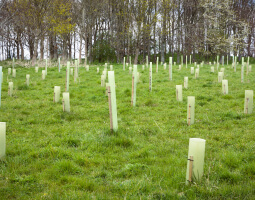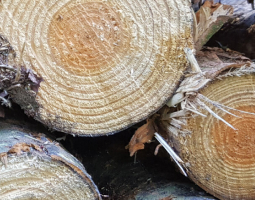Carbon Impacts of Managing Woodlands
Decisions on how a woodland is managed can influence the flows of carbon into and out of a woodland.
Many decisions about forestry practices depend on the management objectives for the woodland, which may be to support habitat creation, timber production, carbon sequestration, or a combination of these and/or other objectives.
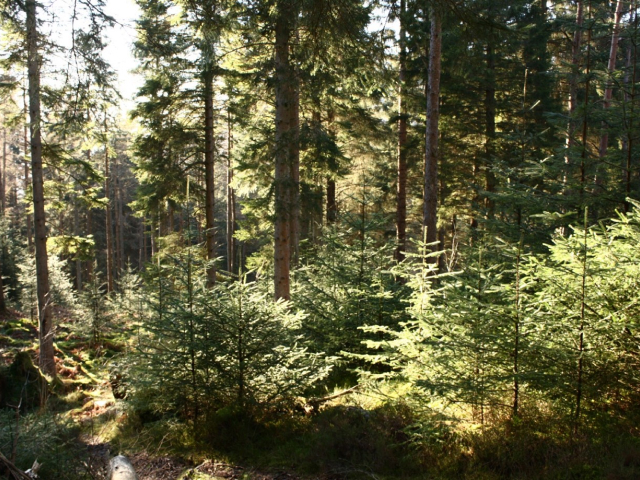
Management Decisions and Carbon
Decisions about woodland creation and management at different stages of forest development can have different impacts on carbon uptake and losses in forestry.
If a forest landscape is managed in a consistent way, (e.g. conventional rotations with same species restocking) the carbon stocks of the landscape tend to reach a steady state, where the rate at which carbon is gained during growth, and lost through respiration, decomposition and harvesting, are in balance. See our carbon sequestration page for further information.
The objectives for woodlands can change over time, so landowners may decide to change management. For example, they may decide to adopt more intensive harvesting or reduce or minimise management interventions in woodlands.
Management changes can have both positive and negative impacts on carbon stocks and sequestration. Generally, increasing harvesting intensity will reduce forest carbon stocks, but may increase carbon stocks in wood products, and have additional greenhouse gas (GHG) benefits if wood products can substitute for GHG-intensive products, such as concrete.
Where woodlands are not actively managed, they can still increase their carbon stocks, however this may reduce both economic value from wood production and the long-term benefits of wood products retaining carbon and displacing GHG emissions. Unmanaged woodlands may also be at increased risk of carbon loss from disturbance, such as fire, pest, disease or storm damage.
Establishing Woodlands
In temperate zones, such as Britain, forest soils can contain as much carbon as the trees, and some soil types can contain considerably more. Therefore, ground preparation, vegetation removal and increasing soil drainage for tree planting disturb the soil and can lead to significant releases of soil carbon through oxidation. Soil carbon losses when establishing new woodland can be particularly large on organic soils with high carbon stocks, and where the soil disturbance is large, as in the case of ploughing, the losses can continue over the long-term. Silvicultural methods that rely on natural regeneration, such as some forms of continuous cover forestry (CCF) can avoid many of the soil carbon losses associated with planting.
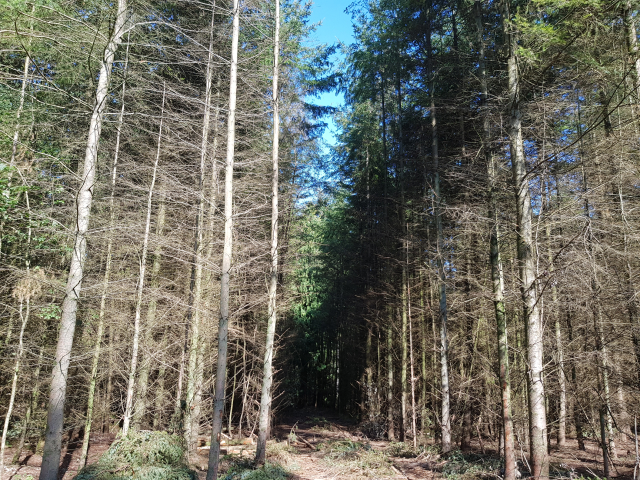
Thinning and Harvesting
Thinning
Thinning is a conventional practice in woodlands managed for timber production, where some trees are removed to benefit the growth of others. Usually, the trees removed when thinning can be used for pulp, for panel boards, or fencing, or wood fuel. The decision on whether to thin a woodland can have an impact on the carbon stock of a forest and the carbon that is transferred into wood products.
Typically, the process of thinning will lead to a woodland with lower standing carbon stocks compared to a similar stand that is not thinned, however the net impact on the carbon balance will depend on the amount of carbon in the forest and in wood products. Thinned stands are more likely to produce good quality timber that can be used for long-term wood products. Thinning can also help maintain a diverse woodland structure, by letting in light and allowing a variety of ground vegetation and understorey to grow, which may contribute to carbon stocks. It can also increase stand stability that can help losses via windblow, but only on relatively sheltered sites.
Harvesting
The harvesting of mature trees is part of normal forestry practice in managed woodlands, and in those managed primarily to produce timber it is the prime source of revenue. Felling mature trees for timber can involve clearing a relatively large area of trees in single-aged stands, a practice known as clearfelling. The timing of clearfelling is often dependent on the growth rate and size of the trees and the desired types of wood product.
Woodlands can also be managed using ‘continuous cover’ forestry (CCF) methods, such as shelterwood and selection systems, which reduce the large but transient reduction in stand carbon stocks that occur with clearfelling. Over the long term the carbon benefits of the two systems at the same site can be similar if assuming the same species, harvest and growth rates, though CCF can help reduce soil carbon losses.
When managing for habitat or nature conservation, thinning or group felling may be practised to create more diverse stand structures such as multi-aged and possibly multi-species woodlands with continuous cover management. These practices can result in woodland carbon stocks being temporarily reduced as the stand is managed towards a more complex structure, but by avoiding clearfelling they can result in a more stable woodland carbon stock in the long term.
Any thinning or harvesting will leave residual material in the woodland, the ’brash’ of side branches and the tops of trees, as well as the stumps. These continue to contribute to the soil and therefore total woodland carbon stock until they decay, releasing carbon back to the atmosphere. Larger material may take decades to decay.
Fossil fuels are consumed during machinery operations, forestry infrastructure construction (such as roads, drains, bridges, fencing) and transport of harvested wood. These activities therefore all result in GHG emissions, mainly carbon dioxide and nitrous oxide, but usually these emissions are negligible compared to the carbon uptake during tree growth.
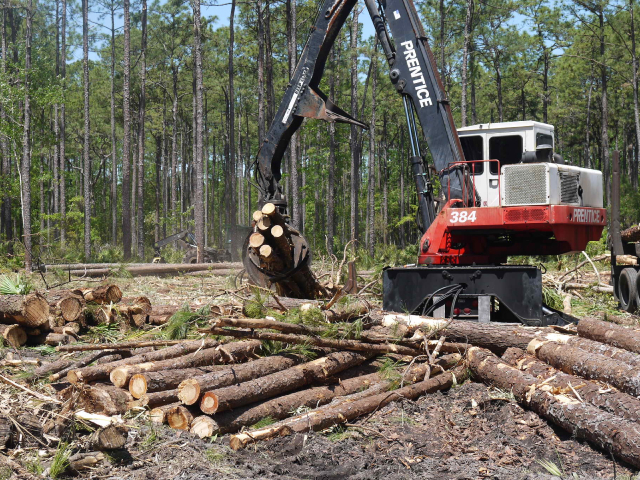
Overview
Although active woodland management may be important to achieve many objectives, it is not essential to maintain substantial rates of carbon sequestration. Woodland managed with a minimum intervention approach can still result in a woodland with a substantial carbon stock. Management can, however, improve timber production, which can have benefits for climate change mitigation where wood products store carbon for the long-term while replacing fossil fuel intensive materials and fuels. Management can also help increase forest resilience to help to reduce impacts of natural disturbance that can result in drastic losses of carbon.


